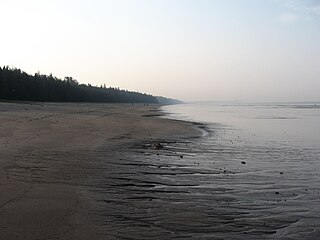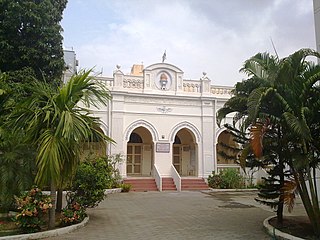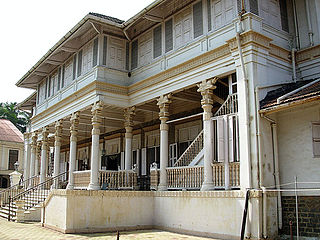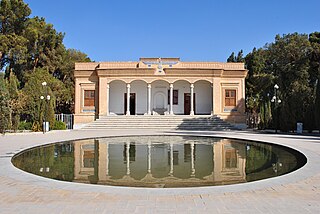
Parsis or Parsees are an ethnoreligious group of the Indian subcontinent adhering to Zoroastrianism. They are descended from Persians who migrated to Medieval India during and after the Arab conquest of the Persian Empire in order to preserve their Zoroastrian identity. The Parsi people comprise the older of the Indian subcontinent's two Zoroastrian communities vis-à-vis the Iranis, whose ancestors migrated to British-ruled India from Qajar-era Iran. According to a 16th-century Parsi epic, Qissa-i Sanjan, Zoroastrian Persians continued to migrate to the Indian subcontinent from Greater Iran in between the 8th and 10th centuries, and ultimately settled in present-day Gujarat after being granted refuge by a local Hindu king.
Byculla is an area of South Mumbai.

A dakhma, also known as a Tower of Silence, is a circular, raised structure built by Zoroastrians for excarnation, in order to avert contamination of the soil and other natural elements by the dead bodies. Carrion birds, usually vultures and other scavengers, consume the flesh. Skeletal remains are gathered into a central pit where further weathering and continued breakdown occurs.

The history of Mumbai, can be traced back to 600 BC, when evidences of the first known settlement, Harrappan civilization, here have been discovered.

A fire temple, Agiary, Atashkadeh, Atashgah (آتشگاه) or Dar-e Mehr is the place of worship for the followers of Zoroastrianism, the ancient religion of Iran (Persia). In the Zoroastrian religion, fire, together with clean water, are agents of ritual purity. Clean, white "ash for the purification ceremonies [is] regarded as the basis of ritual life", which "are essentially the rites proper to the tending of a domestic fire, for the temple [fire] is that of the hearth fire raised to a new solemnity". For, one "who sacrifices unto fire with fuel in his hand ..., is given happiness".
Navsari is the ninth biggest city in the state of Gujarat in India. It is the administrative headquarters of Navsari District. Navsari is situated between Surat & Mumbai. Navsari is a twin city of Surat. It is located 37 km south of Surat. As per 2011 Census of India, Navsari is 16th biggest city of Gujarat state. It ranked 10th most populous city of Gujarat in 1991 Census of India and 2001 Census of India. Navsari is the 25th cleanest city of India according to the Swachh Bharat Urban mission. Dandi village near Navsari was the focal point of the great Salt March led by Mahatma Gandhi during civil disobedience movement of India.
Udvada is a town situated in Pardi taluka in the Valsad district in the state of Gujarat, India. Udvada is a coastal town located around 24 km from the Valsad city. The Zoroastrian temple, Udvada Atash Behram is situated here.

The persecution of Zoroastrians has been recorded throughout the history of Zoroastrianism, an Iranian religion. The notably large-scale persecution of Zoroastrians began after the rise of Islam in the 7th century CE; both during and after the conquest of Persia by Arab Muslims, discrimination and harassment against Zoroastrians took place in the form of forced conversions and sparse violence. Muslims who arrived in the region after its annexation by the Rashidun Caliphate are recorded to have destroyed Zoroastrian temples, and Zoroastrians living in areas that had fallen under Muslim control were required to pay a tax known as jizya.

Nargol is a village located in the Indian state of Gujarat.

Jamshedji Sorab Kukadaru was a Zoroastrian priest in Mumbai, India revered by Zoroastrians for a number of miracles he is believed to have performed. He was well known by his contemporaries for his simple lifestyle and asceticism, as well as his unflinching adherence to priestly purity rules. Most of his life is said to have been spent in prayer.

Zoroastrianism in India has significant history within the country. Zoroastrians have lived in the Indian subcontinent since the Sasanian period. The Zoroastrians also moved to India in successive migrations during the Islamic period. The initial migration following the Muslim conquest of Persia has been canonized as a religious persecution by invading Muslims. Zoroastrianism meanwhile suffered a decline in Iran after the conquests. Subsequent migrations also took place after the attempts by Safavids to convert their subjects to Shiism.

Jal Phiroj Clubwala Dar E Meher, popularly known as the Royapuram fire temple, is a Zoroastrian fire temple at Royapuram, Chennai, India. It was built in 1910 and donated to the Madras Parsi Zarthosti Anjuman by philanthropist Phiroj M. Clubwala. The temple is one of the 177 odd fire temples in the world, of which some 150 are in India. It is the only Parsi fire temple in Tamil Nadu and surrounding region, including Puducherry and Kerala. The flame in the temple is burning continuously ever since the temple was built and is stoked five times a day by the priest.

Parsi Fire Temple is a place of worship for the Parsis in India. Located at MG Road in Secunderabad, Telangana, the temple is believed to have been consecrated in September 1847. The temple was built by two brothers and traders, Pestonji Meherji and Viccaji Meherji, who had settled down in Secunderabad. In addition to the temple, the compound also has residential and commercial buildings. The Parsi population in the twin cities of Hyderabad and Secunderabad is the second largest in India outside Mumbai.

The Iranshah Atash Behram, also known as the Udwada Atash Behram is a sacred fire housed in a temple in Udvada, Gujarat on the west coast of India. It is the first of the eight fire temples of the Zoroastrian religion in the country. The Atash Bahram, meaning "Victorious Fire", is the oldest fire temple in India, dated to the eighth century, and represents the historical cultural and religious links with Iran. The current temple housing the sacred fire was built in 1742 by Motlibai Wadia from Bombay. The temple structure, built spaciously, is well decorated and contains the Dasturji Kaiyoji Mirza hall and a museum. The main hall of the temple is accessed through a two-stage staircase. The temple attracts Zoroastrian pilgrims from all parts of India, Pakistan, and from around the world.

The Fire Temple of Yazd, also known as Yazd Atash Behram, is a Zoroastrian fire temple in Yazd, Yazd province, Iran. It enshrines the Atash Bahram, meaning “Victorious Fire”, dated to 470 AD. It is one of the nine Atash Bahrams, the only one of the highest grade fire in ancient Iran where Zoroastrians have practiced their religion since 400 BC; the other eight Atash Bahrams are in India. According to Aga Rustam Noshiravan Belivani, of Sharifabad, the Anjuman-i Nasiri opened the Yazd Atash Behram in the 1960s to non-Zoroastrian visitors.
The role of women in the Zoroastrian and Parsi communities remains controversial and significant. Gender roles in the community have slowly been evolving as societal norms around them progress.

Maneckji Seth Agiary is the second-oldest Zoroastrian fire temple in Mumbai, India, constructed in 1735. Banaji Limji Agiary, established in 1709, is the oldest. As in all Zoroastrian temples, non-Parsis are not allowed to enter. The architecture of the building is a mix of Persian and Greek Revival styles, with two lamassus standing guard at the temple entrance.

Sharifabad, Ardakan is a township in the Central District of Ardakan County, Yazd Province, Iran. It is located near the county capital, Ardakan, and had a population of 4,000 as of the 2006 census. Sharifabad is one of the Zoroastrian centres of Iran, home to numerous Zoroastrian holy sites. Every summer, thousands of Zoroastrians from around the world gather here on pilgrimage. Sharifabad is also notable for the 1,000-year-old Qutbabad aqueduct that runs through the village. The village is home to both Muslims and Zoroastrians who worship separately and respect each other's beliefs.
Cusrow Baug is a Parsi residential colony in Colaba Causeway, Mumbai, India. The residential blocks of the colony were built between 1934 and 1959. The colony also houses an agiary, a computer centre, a gymnasium and a sports club. It was designed by Claude Batley.











